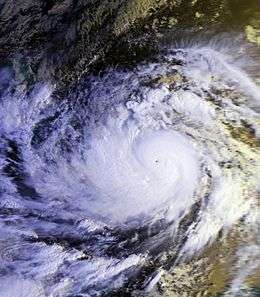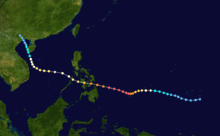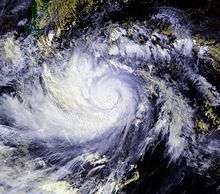Typhoon Mike
| Typhoon (JMA scale) | |
|---|---|
| Category 5 (Saffir–Simpson scale) | |
 Typhoon Mike at peak intensity while approaching the Philippines | |
| Formed | November 5, 1990 |
| Dissipated | November 18, 1990 |
| Highest winds |
10-minute sustained: 220 km/h (140 mph) 1-minute sustained: 330 km/h (205 mph) |
| Lowest pressure |
874mb hPa (mbar) (885 mbar (hPa; 26.13 inHg) according to the JTWC) |
| Fatalities | 748 total |
| Damage | $388.5 million (1990 USD) |
| Areas affected | Caroline Islands, Philippines, Vietnam, China |
| Part of the 1990 Pacific typhoon season | |
Typhoon Mike, known in the Philippines as Typhoon Ruping, was the second strongest typhoon, behind Typhoon Flo, and the deadliest typhoon of the 1990 Pacific typhoon season as it crossed the Philippines in November. Forming from an area of persistent convection over the Caroline Islands, Mike headed westward. Early on the 8th, the depression strengthened to Tropical Storm Mike near Yap. Mike became a typhoon early on November 9, the 18th of the season. On November 10, the typhoon rapidly intensified, reaching peak winds of 165 mph later that day. In a 48-hour period, the typhoon deepened 99 millibars to a pressure of 915 mbar (27.0 inHg). Mike weakened shortly before land interaction and slammed over the eastern Philippines as a 140 mph (230 km/h) typhoon on November 12.
Mike reached a secondary peak of 95 mph (153 km/h) winds on November 14. However, interaction with Vietnam again weakened it to a minimal typhoon. Vertical shear increased, weakening Mike to a tropical storm on the 16th. Early the next day, the storm passed over western Hainan Island, and degraded to a tropical depression that night. After a brief passage over the Gulf of Tonkin Mike hit southern China, then dissipated there on November 18.
A total of 748 people were either killed or reported missing across the Philippines. Damage in the country amounted to $388.5 million, with agriculture accounting for the majority.[1]
Meteorological history

An area of persistent convection over the Caroline Islands was first noted in the Significant Tropical Weather Advisory on November 6. As it headed westward, its outflow rapidly improved, with banding and a more circular cloud pattern. The organization continued, and it was upgraded to Tropical Depression 27W on the 7th. Early on the 8th, the depression strengthened to Tropical Storm Mike near the island of Yap.[2]
Mike continued its westward movement and its intensification rate, and became a typhoon early on November 9, the 18th of the season. At this time, a weakness in the subtropical ridge, which kept the storm on its westward movement, was bring Mike northward. This did not occur, and Mike kept its persistent westward motion. On November 10, the typhoon rapidly intensified, reaching peak winds of 165 mph later that day. In a 48-hour period, the typhoon deepened 99 millibars to a minimum central pressure of 915 mbar (27.0 inHg).[2] Mike retained its intensity of 165 mph (266 km/h) for a day as it approached the Philippines. Fortunately for the archipelago, the combination of an eyewall replacement cycle and land interaction to its west weakened the super typhoon. Initially, Mike was forecast to move west northwest and make landfall over Metro Manila, Southern Luzon, and Bicol region, but Mike slammed over the eastern Philippines as a 140 mph (230 km/h) typhoon on November 12. The typhoon further weakened to an 85 mph (137 km/h) typhoon while crossing the islands, but in the South China Sea, conditions favored slight strengthening.[2]
Mike reached a secondary peak of 95 mph (153 km/h) winds on November 14, but land interaction with Vietnam again weakened it to a minimal typhoon. The forecast break in the subtropical ridge finally occurred on the 15th, causing a northwest motion. Vertical shear increased, weakening Mike to a tropical storm on the 16th. Early the next day, the storm passed over western Hainan Island, and degraded to a tropical depression that night. After a brief passage over the Gulf of Tonkin Mike hit southern China where it dissipated on November 18.[2]
Impact
Caroline Islands
While crossing the western Caroline Islands, Mike proved to be quite destructive. Extensive damage occurred to the islands, but no deaths occurred and only one injury was reported.
Philippines

More than 50,000 people fled their homes when Mike made landfall.[3] 16 crewmen of the commercial vessel MV Dona Roberta were reported missing after it sank from strong waves in the south, and a sailor was missing when one of the four Navy ships sank at the Cebu port. Two sailors that were missing earlier were rescued.[3] 12 passenger ships sank while anchored at the Cebu wharf but no fatalities were reported. It was reported that 6 people drowned in Leyte province and 3 others died in adjacent provinces.[3] In Negros Occidental province, 3 people drowned in 1.6 m (5.2 ft) waters. Mike spared Manila's metropolitan area but the central provinces reported gusty winds that knocked out power and destroyed communication facilities in some areas.[3] Red Cross and civil defense officials stated that a tornado was spawned near Cagayan de Oro and left millions homeless.[3] On Panay Island, at least 2 people were killed, including a 10-year-old boy being hit by a tree. 3 other bodies were recovered from the surf off Misamis Oriental in Mindanao.[4] Another ship called the Iligan Flores was missing off the coast of Mindanao but no reports about the fate of the passengers and crew.[4] In Bohol, 20 people were killed and floods up to 10 feet high submerged rootcrops and houses in Loboc and Loay towns.[5] The typhoon injured about 500 people and caused $275 million (1990 USD) in damage to property and crops. The storm forced 3.2 million Filipinos to seek temporary shelter in schoolhouses and evacuation centers. Mike destroyed 116,512 homes and severely damaged 294,131 others.[6] At least 17 people, including 6 Americans, were trapped on an oil rig off Palawan Island after 68 other workers were evacuated.[7] The typhoon's heavy rainfall produced mudslides which, combined with the heavy wind damage, resulted in over $14 million in damage (1990 USD, $20.8 million 2005 USD). Over 748 people were reported killed, making Mike the most destructive typhoon for the Philippines since Typhoon Ike in 1984, which killed over 1,000 people.[8] President Corazon Aquino declared a state of calamity in the Visayas. Typhoon Mike's damage to the infrastructure of the city and province of Cebu forced its local leaders to rethink governmental priorities. A conscious effort to rebuild after the damage was promoted, resulting in the boom of the economy of Cebu, dubbed CEBOOM.
Aftermath
Due to the severity of damage and loss of life caused by the storm, the name Mike was retired and replaced with Manny.[9] PAGASA also retired the name Ruping for similar reasons and was replaced with Ritang, which was first used in the 1994 season.[10]
See also
- List of tropical cyclones
- Typhoons in the Philippines
- Typhoon Son-Tinh (2012)
- Other tropical cyclones that have struck the Central Philippines and claimed more than 1,000 lives
References
- ↑ "Philippines Typhoon Mike Nov 1990 UNDRO Situation Reports 1-6". United Nations Department of Humanitarian Affairs. ReliefWeb. January 3, 1991. Retrieved April 23, 2015.
- 1 2 3 4 "JTWC Mike Report" (PDF). Joint Typhoon Warning Center. November 1990.
- 1 2 3 4 5 Reuter (November 14, 1990). "Typhoon Kills 12 in Central Philippines". New Straits Times. Retrieved May 14, 2013.
- 1 2 Associated Press (November 14, 1990). "Typhoon Kills 5 in the Philippines". Gainesville Sun. Retrieved May 16, 2013.
- ↑ Fred, Araneta; Manny, Bautista (18 November 1990). "20 die; ₱134M damage". The Bohol Chronicle. Retrieved 10 September 2016.
- ↑ "Typhoon Leaves 235 Dead in Philippines". Moscow-Pullman Daily News. November 20, 1990. Retrieved May 16, 2013.
- ↑ "Strong Typhoon Hits Philippines; 19 Missing". The Free Lance-Star. November 13, 1990. Retrieved May 16, 2013.
- ↑ Philippine Atmospheric Geophysical and Astronomic Services Administration. Most Destructive Tropical Cyclones for Month of December (1948-2000). Retrieved on February 4, 2007.
- ↑ Xiaotu Lei and Xiao Zhou (Shanghai Typhoon Institute of China Meteorological Administration) (February 2012). "Summary of Retired Typhoons in the Western North Pacific Ocean". Tropical Cyclone Research And Review. 1 (1): 23–32. doi:10.6057/2012TCRR01.03. Retrieved May 7, 2013.
- ↑ Cimatru, Frank (November 2, 2006). "Typhoon Naming". Pine for Pine. Archived from the original on December 20, 2014. Retrieved December 20, 2014.